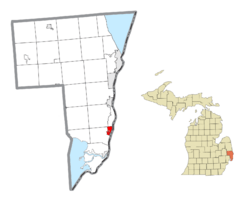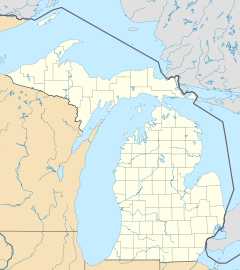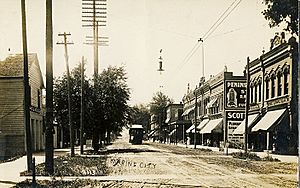Marine City, Michigan facts for kids
Quick facts for kids
Marine City, Michigan
|
|
|---|---|

Marine City from across the St. Clair River
|
|
| Motto(s):
A Community of 1000 Adventures
|
|

Location within St. Clair County
|
|
| Country | United States |
| State | Michigan |
| County | St. Clair |
| Platted | 1835 |
| Government | |
| • Type | Council–manager |
| Area | |
| • Total | 2.90 sq mi (7.50 km2) |
| • Land | 2.16 sq mi (5.58 km2) |
| • Water | 0.74 sq mi (1.91 km2) |
| Elevation | 584 ft (178 m) |
| Population
(2020)
|
|
| • Total | 4,079 |
| • Density | 1,891.93/sq mi (730.45/km2) |
| Time zone | UTC-5 (Eastern (EST)) |
| • Summer (DST) | UTC-4 (EDT) |
| ZIP code(s) |
48039
|
| Area code(s) | 810 |
| FIPS code | 26-51600 |
| GNIS feature ID | 1624706 |
Marine City is a city in St. Clair County, Michigan. It sits on the west bank of the St. Clair River. This city is part of the "River District," located north of Detroit and south of Lake Huron. In the late 1800s, Marine City was a major center for building wooden ships and processing lumber.
The city's population was 4,079 people at the 2020 census. Marine City used to have an international car ferry service. This ferry, called The Bluewater Ferry, connected Marine City to Sombra, Ontario, Canada, across the river.
Contents
History of Marine City
The land where Marine City is now was once home to the Ojibwa people for many centuries. In the 1600s, French fur trappers and missionaries came to the area. Later, settlers arrived on both sides of the Detroit and St. Clair rivers.
French farmers created long, narrow land plots. These plots had their narrow ends along the river. The first Catholic Church was built by French Catholics at Catholic Point. They bought this land before the United States was formed. French Canadians also lived across the river in a small farming community called Petite Côte.
More European-American settlers arrived after the American Revolution. In the 1780s, they bought land from the Chippewa Indians. Americans started calling the community "Yankee Point." This was because many settlers came from New England and New York. They also called the settlement "Belle River," like the French did. This name later became a neighborhood name.
The village was mapped out, or "platted," by Americans as Newport between 1835 and 1837. It was known as "Newport" for 31 years, but it was never officially named that. In 1865, it became the Village of Marine City. The village grew quickly because of the lumber trade and shipbuilding. It officially became a city in June 1887.
The late 1800s were a time of great growth for Marine City. Many people worked in the lumber and shipping industries. Large rafts of lumber were floated down the St. Clair River each spring. This lumber was processed in Marine City or Detroit. Shipyards in the city built many wooden ships that sailed the Great Lakes.
Lake steamers carried passengers to small towns around the lakes. Marine City had a park by the St. Clair River. Bands played music in the bandstand at City Hall during the summer.
As the lumber business slowed down, the area became linked to other resources. Freighters carried iron from Duluth, Minnesota, mined in the Mesabi Range. This iron went to Ashtabula, Ohio, for steel processing. These ships traveled from Lake Superior through Lake Huron to Lake Erie. Marine City became known as the town where captains of lake freighters lived. Many of these captains worked for the Pittsburgh Steamship Company. This company was formed in 1901 and became the largest shipping fleet on the Great Lakes.
In the 21st century, Marine City has become a popular spot for antique stores. The Snug Theater is a small theater with 98 seats that hosts live shows. Another theater, The Riverbank Theater, opened in 2014/2015. It is in a former bank building. The old Mariner Theatre is now a special event center and movie theater. It also displays fine art models, including a model of the ocean-going Titanic. Downtown restaurants and shops also welcome visitors and residents.
The Heather House is now a bed and breakfast. It was built in the Queen Anne Victorian style and finished in 1885. William Sauber, a chief engineer for the Mitchell fleet of Great Lake steamers, owned it.
Geography of Marine City
Marine City is located in a unique area of Michigan.
Land and Water Area
- The city covers a total area of about 2.46 square miles (6.37 square kilometers).
- About 2.15 square miles (5.57 square kilometers) of this is land.
- The remaining 0.31 square miles (0.80 square kilometers) is water.
Regional Location
- Marine City is considered part of "the Thumb" region of Michigan.
- The Thumb is a subregion of the Flint/Tri-Cities area.
- It is also part of the "Blue Water Area," which is another subregion of the Thumb.
- The city is part of the larger Detroit-Warren-Livonia Metropolitan Statistical Area (MSA). This means it's part of a large urban area.
- It is also part of the Detroit-Ann Arbor-Flint Combined Statistical Area (CSA). This is an even larger group of connected urban areas.
Population and People
This section shares information about the people living in Marine City.
| Historical population | |||
|---|---|---|---|
| Census | Pop. | %± | |
| 1870 | 1,240 | — | |
| 1880 | 1,673 | 34.9% | |
| 1890 | 3,268 | 95.3% | |
| 1900 | 3,829 | 17.2% | |
| 1910 | 3,770 | −1.5% | |
| 1920 | 3,731 | −1.0% | |
| 1930 | 3,462 | −7.2% | |
| 1940 | 3,633 | 4.9% | |
| 1950 | 4,270 | 17.5% | |
| 1960 | 4,404 | 3.1% | |
| 1970 | 4,567 | 3.7% | |
| 1980 | 4,414 | −3.4% | |
| 1990 | 4,556 | 3.2% | |
| 2000 | 4,652 | 2.1% | |
| 2010 | 4,248 | −8.7% | |
| 2020 | 4,079 | −4.0% | |
| U.S. Decennial Census | |||
2010 Census Information
According to the census from 2010, Marine City had 4,248 people. There were 1,765 households and 1,117 families living in the city.
- Population Density: There were about 1,975.8 people per square mile (762.9 people per square kilometer).
- Housing: There were 2,015 housing units. On average, there were 937.2 housing units per square mile (361.9 per square kilometer).
Racial Makeup
The racial makeup of the city in 2010 was:
- 96.8% White
- 0.3% African American
- 0.7% Native American
- 0.2% Asian
- 0.5% from other races
- 1.6% from two or more races
- Hispanic or Latino people made up 1.7% of the population.
Households and Families
- Of the 1,765 households, 31.1% had children under 18 living with them.
- 44.6% were married couples living together.
- 13.3% had a female head of household with no husband present.
- 5.4% had a male head of household with no wife present.
- 36.7% were not families.
- 31.3% of all households were made up of individuals living alone.
- 14% had someone living alone who was 65 years old or older.
- The average household size was 2.41 people.
- The average family size was 3.00 people.
Age Distribution
The average age in Marine City in 2010 was 40.2 years.
- 22.9% of residents were under 18 years old.
- 8.2% were between 18 and 24 years old.
- 25.8% were between 25 and 44 years old.
- 27.9% were between 45 and 64 years old.
- 15.3% were 65 years old or older.
- The city's population was 48.2% male and 51.8% female.
Famous People from Marine City
Marine City has been the birthplace or home of several notable individuals:
- Steve Fisher (1912–1980): An author and Hollywood screenwriter.
- Stephen Benedict Grummond (1834–1894): An industrialist and mayor of Detroit from 1884 to 1885.
- Jeff Gutt (born 1976): He was the second-place finisher on The X Factor singing competition in 2013. He is currently the lead singer for the band Stone Temple Pilots.
- Brendon Kay (born 1989): A former quarterback for the Cincinnati Bearcats college team. He also briefly played for the Pittsburgh Steelers.
See also
 In Spanish: Marine City (Míchigan) para niños
In Spanish: Marine City (Míchigan) para niños



